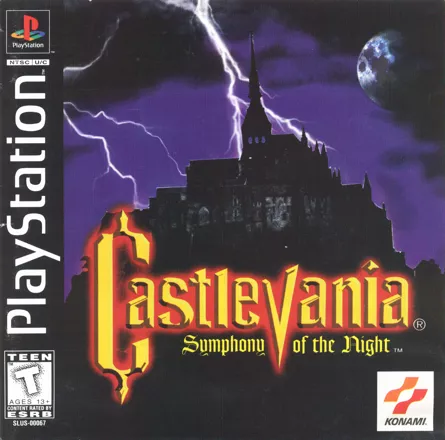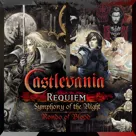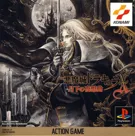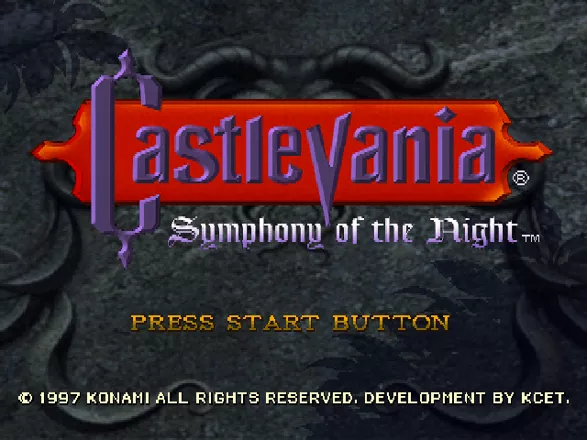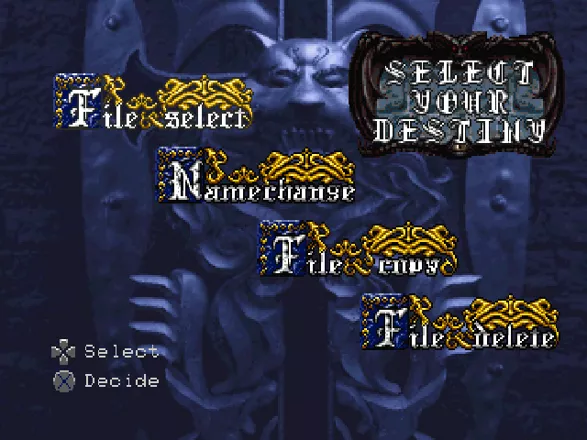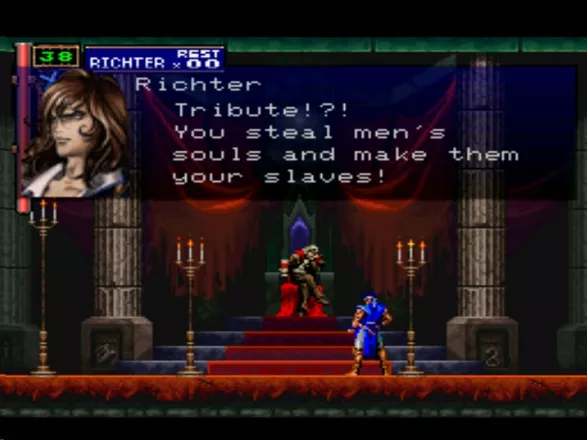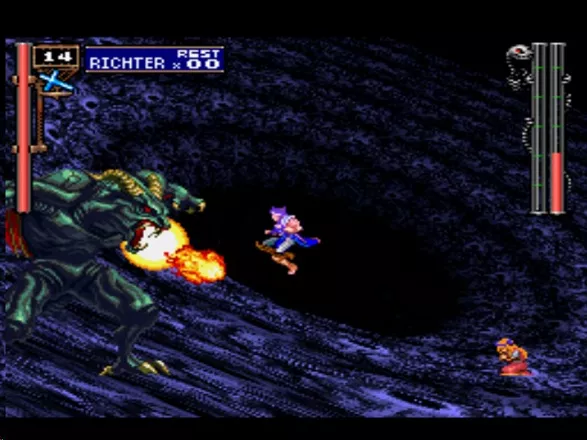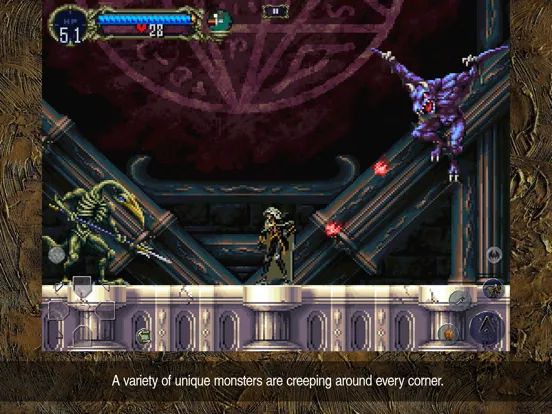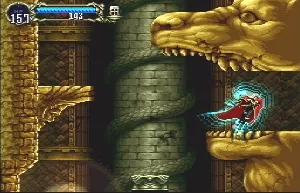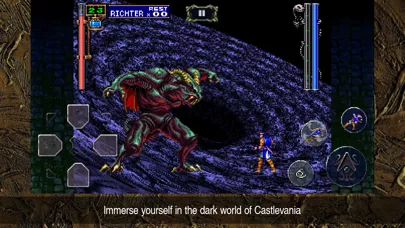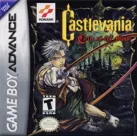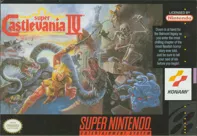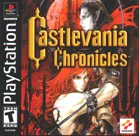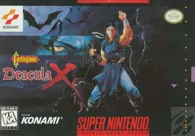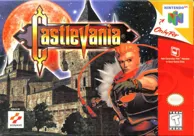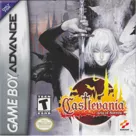Castlevania: Symphony of the Night
- Castlevania: Symphony of the Night (1998 on Dedicated handheld)
Description official descriptions
Five years ago, Richter Belmont, the latest in the Belmont lineage and the one destined to be a Vampire Hunter, defeated Dracula in a brutal battle which nearly cost him the love of his life, Annette, and her sister, Maria. Now, Richter has suddenly vanished, Dracula's castle has mysteriously reappeared, and Maria, now a young woman, sets off to find Richter. Alucard, the son of Dracula, is awakened from his eternal slumber after this large shift in power and enters into the castle to find some answers and confront his father.
Symphony of the Night is a direct sequel to Rondo of Blood. Unlike the previous installments of the series, the game is set in a castle which the player can explore freely with many different paths, although often items in certain areas need to be found that will allow passage to others. The action-based gameplay incorporates now strong RPG elements. The hero receives experience points for defeating enemies, gains levels, and becomes more powerful. There is also money to be found in the game, and various accessories to buy. In a separate screen, players need to equip attack weapons, shields, and other items. Magic plays an important role, as well as secondary weapons and a large amount of "special moves" that are executed similar to advanced one-on-one fighting games.
The Saturn release adds two new areas to the castle (the Underground Garden and the Haunted Path), a third playable character (Maria), and a few new remixed music tracks. However, it sacrifices a few of the graphical effects from the PlayStation version, particularly true transparencies. The iOS and Android versions are based on the version found in the Castlevania: The Dracula X Chronicles release (has the Saturn versions familiars and items). All the other releases are based on the PlayStation version and do not feature these changes.
Spellings
- 悪魔城ドラキュラX 月下の夜想曲 - Japanese spelling
Groups +
- Castlevania / Akumajō Dracula series
- Enhanced ports / Port differences
- Fictional character: Count Dracula
- Gameplay feature: Bestiary
- Gameplay feature: Multiple endings
- Gameplay feature: Transformation
- Games with original fan translations into English
- Genre: Explorable platformer / Metroidvania
- PlayStation Greatest Hits releases
- PlayStation the Best series
- Theme: Vampires
- Visual technique / style: Parallax scrolling
Screenshots
Promos
Videos
Add Trailer or Gameplay Video +1 point
See any errors or missing info for this game?
You can submit a correction, contribute trivia, add to a game group, add a related site or alternate title.
Credits (PlayStation version)
82 People (65 developers, 17 thanks) · View all
| English Voice Cast | |
| JP Voice Cast |
|
| Producer | |
| Assistant Director | |
| Localization A.D. | |
| Programmers |
|
| Designers | |
| [ full credits ] | |
Reviews
Critics
Average score: 91% (based on 76 ratings)
Players
Average score: 4.2 out of 5 (based on 287 ratings with 6 reviews)
The Good
Let's just start at the beginning: I never liked the PlayStation very much at all. Lack of decent 2D support, too many sports titles, not enough variety in other genres, and no RPGs at the beginning pretty much told me to wait and perhaps get a Sega Saturn. Then, came the announcements: Final Fantasy VII, a possible Metal Gear game, the remakes of the Lunar games, and Castlevania: Symphony of the Night. That settled it: I now had to get a system I didn't even want. So I went, got a PlayStation, and waited for Castlevania. It came, I bought, I played, and I thought this game kicked plenty of ass.
Now I'm glad that I own a PlayStation. Read on to find out why.
Anyone who's familiar with old-school Castlevania knows its formula. The CV games were all platform-style games, in which you moved from left to right, and maybe down to up, attacking enemies, grabbing items and weapons, and then killing Dracula in the end. BUT...Konami decided that their 32-bit CV debut should be something special. And indeed it is! Now, instead of just a simple platforming experience, Konami went and took a nod to one of the best games ever: Super Metroid. Instead of set stages, you have one HUGE (or two if you beat the game a certain way) castle to make your way through, with all of its areas being connected in some way or another. This means you can explore the castle as you wish, but in some cases you have to visit a certain area to find an item that'll help you explore another area (again, Super Metroid). Now people must be worried as hell that the PSX can't keep up with loading a castle like this, but never fear. Before entering a new area, you always will pass through a small hallway with a CD icon in the ceiling. These special "loading" rooms will load the next area before you pass through the other side, meaning that you barely have to wait before entering the next area. There are also a TON of secret areas, usually hidden behind walls, under floors, and above ceilings. That means that those players out there (and you know who you are!) looking to get a perfect map percent are going to have a lot of fun!
Ok, so the premise is covered...what about gameplay? Well, to compliment the massive castle and your constant wandering, SOTN mixes some RPG elements into the classic formula. Alucard can gain experience and levels from defeating enemies, and he can find a whole slew of weapons, armor, accessories, helmets, cloaks, items, etc., in order to aid him on his quest. He can even get money in this game, which he can use to purchase items and hints. Some weapons seem useless, while others, like the Crissaegrim (GRIMMY!!) can be cheap as hell, but with such a massive variety of weapons, it'll be fun just to try them all out to see what they can do! And about the experience system: as you gain levels, weaker enemies deal less and less experience points, meaning it's going to get tough trying to reach Level 99 (the highest level). But since there's so much to do and find, you'd probably want to try and reach Level 99 anyway! As for the rest of the gameplay, it's tight and perfected. Controls are easy to remember: one button for the left hand, one for the right hand, a jump button, a "slide" button (Alucard dashes backwards with it, really), one to bring up the map, and the shoulder buttons are used for the three transformations Alucard can find: the bat allows Alc to fly and use sonar to find his way in darkened areas, the wolf allows him to charge and dash very quickly, as well as attack enemies, and the mist allows Alc to pass through vents and grates with ease. Alc also moves with extreme precision; he moves when you press the D-pad, and he stops when you let go. There are no pits in this game where you can die instantly, so you don't have to worry about cheap deaths.
Now, onto the graphics. For being a system with crappy 2D capabilities, Konami really managed to squeeze a ton of 2D effects and cram a HUGE amount of detail into this much-misaligned little beast. Everything, and I mean EVERYTHING, is drawn with the most exquisite and tiny detail, and the whole entire game is so beautifully animated and drawn that if it weren't for the PSX pad and the green light on the PSX being on, I would've almost thought that I was playing my Saturn! (small plug: yes, the Saturn IS the better 2D machine.) There are a ton of special effects used in this game, like transparency, scaling and rotation, and much more!
Sounds and music: DON'T, under any circumstance, be stupid and turn off the volume of your TV to put on some outside music. Absolutely DON'T!! You'll be missing out on one of the best soundtracks composed for ANYTHING. Simply put: SOTN has one of the most beautiful, moving, riveting soundtracks of any game ever, with many different styles throughout. Period. From "Dracula's Castle" (the entrance hall theme) to "Wood Carving Partita" (the Long Library theme), from "Festival of Servants" (the boss theme!!) to "Wandering Ghosts" (the Colloseum theme; and my favorite!), it's just...I can't even describe it. The soundtrack for the game is a hell of a purchase, I'll tell you that much. The sound effects are the perfect compliment to the action, with plenty of crisp clangs, crashes, screams of dead zombies, fwooshes, and a whole ton of other effects. And then...there's the VOICE ACTING!! YES!! If you've got the Japanese version, be prepared to be treated to some of the best voice acting you'll ever hear in your life! It's perfectly chosen, acted, and fits in with the game like a glove. If you've got your PSX hooked up to a stereo system, crank that sucker up to max!
Another cool thing about the game are the tons of Easter eggs and references to previous CV games and Konami games. I'm not going to go into too much detail, but I will say to keep your eyes peeled.
The Bad
Konami's treatment of the English version. They ought to be lynched.
First, the voices in the English version are terrible. Absolutely terrible. Alucard had probably the best voice in the Japanese version, but his English voice is just...ARRGH!! What is this damn obsession with making all the heroes have to sound like John Wayne!? Even his grunts, yells, and saying spell names are terrible! Richter is even worse: his Japanese voice sounded an awful lot like his voice from the first Dracula X (the U.S. never got that particular chapter, though), but in the U.S. version, he sounds like he has a damn cold! What the hell!?? Dracula is simply a joke: his English voice actor sounds like he gargles gravel. Maria's English voice sounds like the actress either sleeps too much or sleeps too little...constant sighs and breaths, plus the immortal "Do you know the name....HHHHHHRRRICHHTAA Belmont?". ARRRRGH!!!
And besides the voices, several cool items from the Japanese version were removed, namely the Halfling Faerie and the Nose Goblin. Even if they weren't entirely useful, they still completed the collection! There were also a couple of weapons I found in the Japanese version that I didn't in the U.S. version, but they were just tiny variations of existing weapons. As for censorship, perhaps? Surprisingly, not much. The succubus is still in the nude (except where her wings connect to her body; she's wearing a little leather strap there), as are the Venus Weeds. But I've noticed that some enemies that were SUPPOSED to bleed in the Japanese version don't in the U.S. version. For SHAME, Konami!!
The Bottom Line
Despite idiotic localizing of this game, Symphony of the Night is still one of the best PSX games in existence. Buy, play, enjoy, and play some more!
PlayStation · by Satoshi Kunsai (2007) · 2001
The Ultimate Sidescrolling Platformer
The Good
This game has all of the elements of a great title: silky controls, great graphics, super style points (you can change the color of the interior and exterior of Alucard's cape), great story (yeah, its not much, but it does the job well enough), huge levels, great map design, tremendous replay value, oh, and did I mention that its Castlevania? The inclusion of a combo system, special moves, hundreds and hundreds of items, and a castle that is, literally, in hell, make this game great fun to play. The experience point elements of the game keep you coming back for more and more and more and more. The familiars are really fun too.
The Bad
... If I HAVE to say something here, I'd have to ad that the familiars come along a little late in the game and are very hard to power up into anything that can effectively help you combat drac's demon hordes. Still, I did get my skull familiar up to the 60's in terms of level (it only took three weeks! God, this game was addictive).
The Bottom Line
The best run and jumper ever made that doesn't use guns; Alucard can only use melee weapons (pursuent to the castlevania tradition).
PlayStation · by Seth Barkan (2) · 2003
The Good
You are never done playing this game. The replayability factor is about as good as you can possibly get. It goes beyond just beating the game. There's finding the inverted castle, finding all the relics, beating all the bosses, getting all the weapons... The list goes on and on and on into infinity. For this reason, Castlevania: SOTN never gets boring to play. Really, that is all I should need to say about this game for everybody who reads this review to immediately go out and buy it (hell, buy a freakin' playstation if you don't have one, just for the sake of playing this game). It should seem like a holy miracle that there could possibly be such a game. I shouldn't need to tell you about the beautifully designed levels and play environment, or the easy-to-play interface or any of that other good stuff. That should be all you need.
The Bad
Some of the bosses are too easy. Yep, that's it. Period.
The Bottom Line
I really can't think of anyone who wouldn't like this game, except for maybe a disgruntled Konami employee in a mental institution somewhere. The big picture: You're the good-hearted son of Dracula and it's up to you to stop him from being resurrected and terrorizing humankind for all eternity. To do so, you must destroy his minions in his evil castle, find items and relics that will help you and enlist the help of characters like the castle librarian and the beautiful Maria Renard. Enjoy.
PlayStation · by Sam Tinianow (113) · 2001
Discussion
| Subject | By | Date |
|---|---|---|
| Bug or graphical effect? | Unicorn Lynx (181628) | Apr 4, 2012 |
| DS | Wormspinal (619) | Jun 21, 2009 |
| Symphony of the Night/ PS2 memory card problem | Michael Sanders | Jan 12, 2008 |
Trivia
1001 Video Games
Castlevania: Symphony of the Night appears in the book 1001 Video Games You Must Play Before You Die by General Editor Tony Mott.
Cancelled Game.Com version
A port of the game was planned for Tiger's short-lived Game.Com handheld console. The game made it apparently to beta state, and several screenshots can be found of it on the net.
CD music
Place the CD into any CD player and play Track 2. You'll get a clip of Alucard saying that this is a PSX black disc, and not to play Track 1. Then comes a remix of Dracula's Castle, the musical piece that plays in the entrance hall of the castle! (WARNING: Do NOT, under any circumstances, play Track 1 of the PSX CD on your CD player, unless you like the sounds of horrible white noise destroying your speakers and your ears.)
Endings
There are 5 possible endings for the game, they are triggered by: killing Richter with the Holy Glasses; Killing Richter without the Holy Glasses; Killing Dracula with less than 200%; killing him with over 200%; and of course, the "Castlevania Classic" Richter ending.
What few people know is that a sixth ending was planned but eventually scrapped from the final game, this ending is a variation of the "vs Richter" ones, and has Maria coming in to his rescue, then transforming into some sort of demon and fighting Alucard. No part of this ending was coded so don't bother looking for it, but the voice files are in the game cd, you can extract it using any PSX-extracting utility and listen to the entire recorded audio (including Alucard mourning Maria and Richter upon victory).
Fan translation
On September 5, 2009, the freelance translators Devil Hackers released a translation patch that fully translates the Japanese version of Castlevania: Symphony of the Night into English. The reason for this release is the notoriously low quality of the official translation. Also, since this patch is for the Japanese version, the players can also be spared the poor voice acting of the US release.
The link to the patch can be found under the Links/Searches section.
Map
To map all of the two castles (the maximum is 200.6%), you need to use the library recall card when facing Dracula, allowing you to add his room to your map.
Medusa
The yellow Medusa heads will normally turn you to stone. However, on seemingly random intervals, Alucard will turn into a gargoyle statue. There seems to be no advantage to this, and no actual point to it.
References
- When you have the Shield Rod equipped, press Back, Foward+Attack. Alucard will toss out a little swirling ball, which is actually the Shield from the Gradius series. It even protects you from small projectile attacks.
- Adrian Tepes's last name "Tepes" is Romanian for "impaler", a name attached to Count Vlad Dracul, aka Vlad Tepes (Vlad the Impaler), who was Bram Stoker's inspiration for Count Dracula.
Rune Sword
If you have the Rune Sword familiar, then you'll notice that a word appears whenever you throw the sword. That word is "verboten" and it means "forbidden" in German.
Second castle
There is a second castle in the game which is a vertically mirrored copy of the first. To access it you must meet with Maria inside the main clock where whe will tell you the truth behind Richter. The monsters and items in the second castle are much harder than the first and some of the bosses from the first appear as regular monsters.
Title translation
"Symphony of the Night" is not the translation of the Japanese "Gekka no Yasoukyoku", which actually means "Nocturne Under the Moon".
Xbox Live
Castlevania: Symphony of the Night is the first Xbox Live arcade game to break the Xbox 360's 50MB data limit enforced by Microsoft. This rule was originally set up to make all games transferable to the 64MB memory unit. For those interested, the game weighs in at 95.32MB.
Version differences
In the Japanese release of this game there were two extra familiars. They were a second fairy and a second demon which basically had no difference from the two that remained (and explains why they were removed).
The Sega Saturn version of Nocturne (which only saw a Japanese release) had a small difference in the storyline. When you go to meet Maria in the Marble Gallery, she gives you the Holy Glasses in the PSX version. But in the Saturn version, she won't just hand them to you. She tests you by fighting you first.
Awards
- Electronic Gaming Monthly
- November 1997 (Issue 100) - ranked #12 (Best 100 Games of All Time) (PlayStation version)
- March 1998 (Issue 104) - Game of the Year Runner-Up (PlayStation version)
- March 1998 (Issue 104) - PlayStation Game of the Year
- March 1998 (Issue 104) - Action Game of the Year Runner-Up (PlayStation version)
- March 1998 (Issue 104) - Side-Scrolling Game of the Year (PlayStation version)
- March 1998 (Issue 104) - Best Music Runner-Up (PlayStation version)
- March 1998 (Issue 104) - PlayStation Game of the Year Runner-Up (Readers' Choice)
- March 1998 (Issue 104) - Action Game of the Year Runner-Up (Readers' Choice) (PlayStation version)
- March 1998 (Issue 104) - Side-Scrolling Game of the Year (Readers' Choice) (PlayStation version)
- March 1998 (Issue 104) - Best Music Runner-Up (Readers' Choice) (PlayStation version)
- 1998 Buyer's Guide - Best Middle (ie midway through through the game)
- 1998 Buyer's Guide - Best Sequel (PlayStation version)
- 1999 Buyer's Guide - Ranked 4 (Top 10 PlayStation Games)
- January 2002 - Worst Game Line Ever (for "What is a man? A miserable little pile of secrets! But enough talk, have at you!")
- Game Informer
- August 2001 (Issue #100) - #18 in the "Top 100 Games of All Time" poll
- GameSpy
- 2001 – #20 Top Game of All Time
- PSExtreme
- 1997 (Vol. 3, Iss. 3) - Best Game Music of the Year Award
- Retro Gamer
- Issue #37 - #14 in the "Top 25 Platformers of All Time" poll
Information also contributed by Ace of Sevens, Ben K, Big John WV, CaptainCanuck, Fafnir, PCGamer77, Satoshi Kunsai, Tiago Jacques, Unicorn Lynx and Zovni
Analytics
Related Sites +
-
MrP CastleVania Realm!!!
A site with everything you need to know about your castlevania-game! -
New English Translation Patch
The patch translates the original Japanese version into English. -
The Castlevania Dungeon
A hosted fan "shrine" site devoted to all the games of the Castlevania series, including the PlayStation game Castlevania: Symphony of the Night. Content includes game info/descriptions, plot summaries, various kinds of media (images, MP3s, etc.) and links to other Castlevania-related sites. -
Top 10 Castlevania: Symphony of the Night Secrets
A.J. discusses his favourite secrets in Castlevania: Symphony of the Night -
Video review of the Castlevania series (WARNING: Language)
The Angry Video Game Nerd, James Rolfe, reviews games in the Castlevania series. In part 4, he reviews Castlevania: Bloodlines on Genesis and Castlevania: Symphony of the Night on Playstation. -
X360A achievement guide
X360A's achievement guide for Castlevania: SOTN.
Identifiers +
Contribute
Are you familiar with this game? Help document and preserve this entry in video game history! If your contribution is approved, you will earn points and be credited as a contributor.
Contributors to this Entry
Game added by Satoshi Kunsai.
PS Vita added by Fred VT. iPhone, Android, iPad added by Rik Hideto. PSP, PlayStation 3 added by Foxhack. Xbox 360 added by Ben K.
Additional contributors: PCGamer77, Unicorn Lynx, //dbz:, Wormspinal, Dae, Alaka, LepricahnsGold, Eric Smith, Patrick Bregger, Starbuck the Third, Rik Hideto, FatherJack, Hipolito Pichardo, A.J. Maciejewski.
Game added April 9, 2001. Last modified February 6, 2025.


